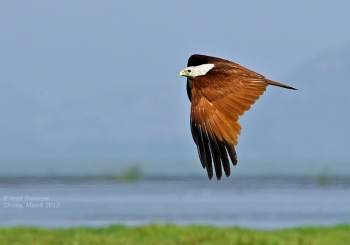Overview
[Map 1]Chilika Lake is a Wetland of International Importance and a Ramsar site. Large flocks of migratory birds make it the largest wintering ground for birds in the area.[1]
Chilika or, as it's called locally, Chilka is a brackish body of water about 40 miles/65km long by 5-13 miles/8-20km wide in Odisha state in eastern India separated from the Bay of Bengal by only a narrow spit of land. It's shallow but is reported to offer good hunting and fishing as well as being a noteworthy stopover for migratory birds. [2]
Birds
Notable Species
The Indian Peafowl, noted as the Indian peacock on the National Portal of India, is the National Bird of India and as such leads off a discussion about notable birds.[1]
Another note of interest is as of just over a year ago during a bird count the number of birds had increased by over 1.55 Lakh, or 155,000. This increase from the last winter brought the total to just under 9 million birds encompassing 147 different species. .[3]
The last count recorded by Avibase has Chilika Lake with 334 recorded species with 8 species globally threatened. .[4]
Rarities
Species recorded as rare for this location include the Herring Gull, Great Bittern, and the Eastern Marsh-Harrier. [4]
Check-list
Birds you can see here include:
Bar-headed Goose, Green-winged Teal, Indian Peafowl, Jungle Bush-Quail, Greater Flamingo, Little Grebe, Orange-breasted Green-Pigeon, Green-billed Malkoha, Gray-bellied Cuckoo, Large-tailed Nightjar, Himalayan Swiftlet, Eurasian Moorhen, Ruddy-breasted Crake, Indian Thick-knee, Black-winged Stilt, Eurasian Oystercatcher, Yellow-wattled Lapwing, Kentish Plover, Greater Painted-Snipe, Pheasant-tailed Jacana, Bar-tailed Godwit, Marsh Sandpiper, Small Pratincole, Pallas's Gull, Great Crested Tern, Asian Woolly-necked Stork, Indian Cormorant, Great White Pelican, Cinnamon Bittern, Indian Pond-Heron, Red-naped Ibis, Osprey, Crested Serpent-Eagle, Brahminy Kite, Barn Owl, Dusky Eagle-Owl, Eurasian Hoopoe, Oriental Pied-Hornbill, White-throated Kingfisher, Blue-tailed Bee-eater, Indian Roller, Blue-throated Barbet, Fulvous-breasted Woodpecker, Eurasian Hobby, Plum-headed Parakeet, Large Cuckooshrike, Black-hooded Oriole, Ashy Woodswallow, Common Woodshrike, Common Iora, White-throated Fantail, White-bellied Drongo, Indian Paradise-Flycatcher, Gray-backed Shrike, Large-billed Crow, Gray-headed Canary-Flycatcher, Cinereous Tit, Indian Bushlark, Jungle Prinia, Paddyfield Warbler, Striated Grassbird, Red-rumped Swallow, Red-whiskered Bulbul, Greenish Warbler, Yellow-eyed Babbler, Indian White-eye, Puff-throated Babbler, Jungle Babbler, Brahminy Starling, Orange-headed Thrush, Oriental Magpie-Robin, Blue Rock-Thrush, Pale-billed Flowerpecker, Crimson Sunbird, Golden-fronted Leafbird, Black-breasted Weaver, White-rumped Munia, Yellow-throated Sparrow, Western Yellow Wagtail, Tawny Pipit.
Other Wildlife
In addition to the large number of birds, both resident and migratory Blackbuck, Spotted Deer, Golden Jackals, and Hyenas call this home. Numerous species of marine life are here also including Prawn, Dolphin, and certain Crustaceans.[3]
Site Information
History and Use
Chilika's history combines both legend and fact.
The legend is that a pirate king, in an effort to conquer the land, anchored offshore hiding for a surprise attack. But material from his ships washed ashore thereby warning the people. In his anger, he caused the sea to enter the lake rendering it how it is today.
The fact?
The lake once was a bay of the ocean, but monsoon rains cause it to silt over leaving it as a lake separated by a small amount of land leaving it as it is today.[5]
Areas of Interest
Bird Island in Rambha, Odisha is noted as a great destination for birders to pursue their craft.
Nalabana in Nalaban, Odisha is a bird sanctuary under the Wildlife Protection Act.
Access and Facilities
With such a large area, a visitor might be best served by consulting a trusted travel professional for assistance with planning a trip to the Chilika Lake area.
References
- National Portal of India - https://www.india.gov.in/
- The Editors of Encyclopaedia Britannica, Chilka Lake, Encyclopaedia Britannica, Encyclopaedia Britannica Inc, June 16, 2015, https://www.britannica.com/place/Chilka-Lake , Accessed September 7, 2020
- Tour My India - https://www.tourmyindia.com/blog/bird-population-increases-in-chilika-lake/
- Lepage D. (2020) Chilika Lake Bird Checklist - Avibase - Bird Checklists of the World. Retrieved 8 September 2020
- Archived History of Chilika - https://web.archive.org/web/20081207100906/http:/www.chilika.com/history.htm
Recommended Citation
- BirdForum Opus contributors. (2024) Chilika Lake. In: BirdForum, the forum for wild birds and birding. Retrieved 27 April 2024 from https://www.birdforum.net/opus/Chilika_Lake
Maps




